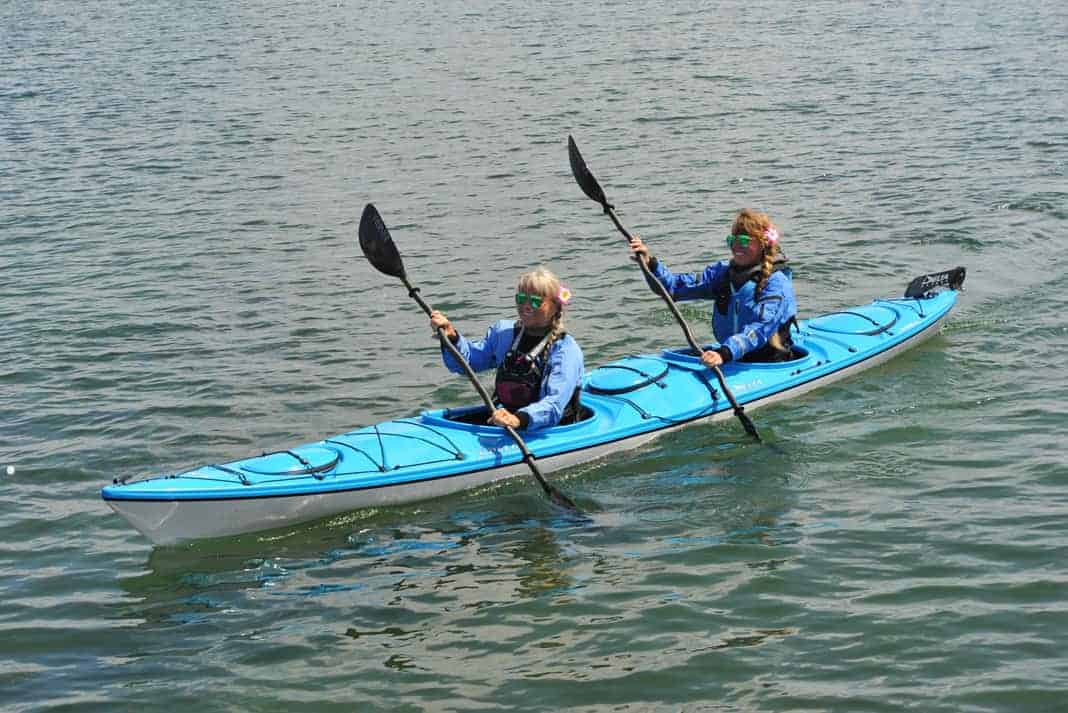Introduction
Embarking on a water adventure with a companion can be an exhilarating experience, and what better way to do so than with a tandem kayak?
These two-seater vessels have become a popular choice for paddlers looking to share the journey, offering a unique blend of stability, speed, and camaraderie.
Whether you’re planning a family outing or a team-building exercise, understanding the ins and outs of a tandem kayak is essential for a successful and enjoyable experience on the water.
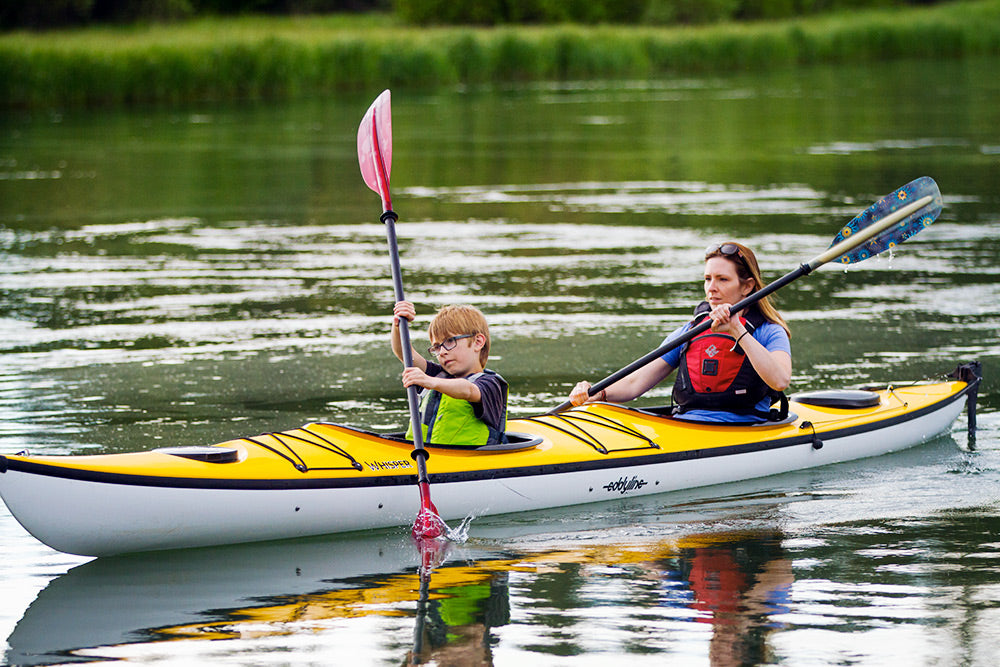
As we delve into the world of tandem kayaking, we’ll explore not only the definition and benefits of these versatile boats but also the important considerations and tips for their use. From the enhanced stability that makes them a favorite for family paddles to the increased speed that excites seasoned kayakers, tandem kayaks offer a distinct paddling experience.
So, let’s set sail into the details of what a tandem kayak is and why it might just be the perfect choice for your next aquatic adventure.
Overview of Tandem Kayaks
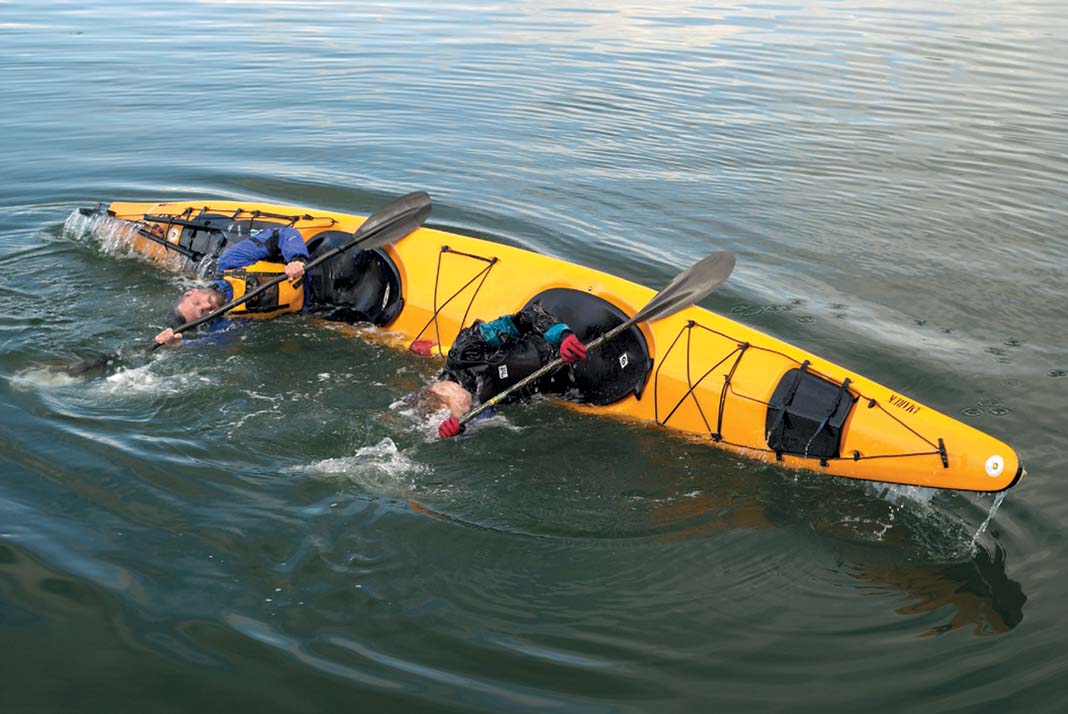
Definition of Tandem Kayak
A tandem kayak, often referred to as a double kayak, is a specialized watercraft designed to accommodate two paddlers simultaneously.
These kayaks are typically longer, ranging from 18 to 24 feet, and broader than their solo counterparts, providing ample space for two individuals to navigate the waters together.
The design of a tandem kayak not only allows for a shared paddling experience but also offers the option for one person to paddle and steer while the other enjoys the ride, making it a versatile choice for various skill levels and preferences.
While tandem kayaks are primarily intended for two-person use, their spacious build also makes them suitable for solo paddlers seeking extra stability and storage capacity.
This adaptability, combined with the social aspect of tandem kayaking, makes it an appealing option for those looking to introduce a partner to the sport or simply enjoy nature’s beauty with a friend or loved one by their side.
Benefits of Tandem Kayaks
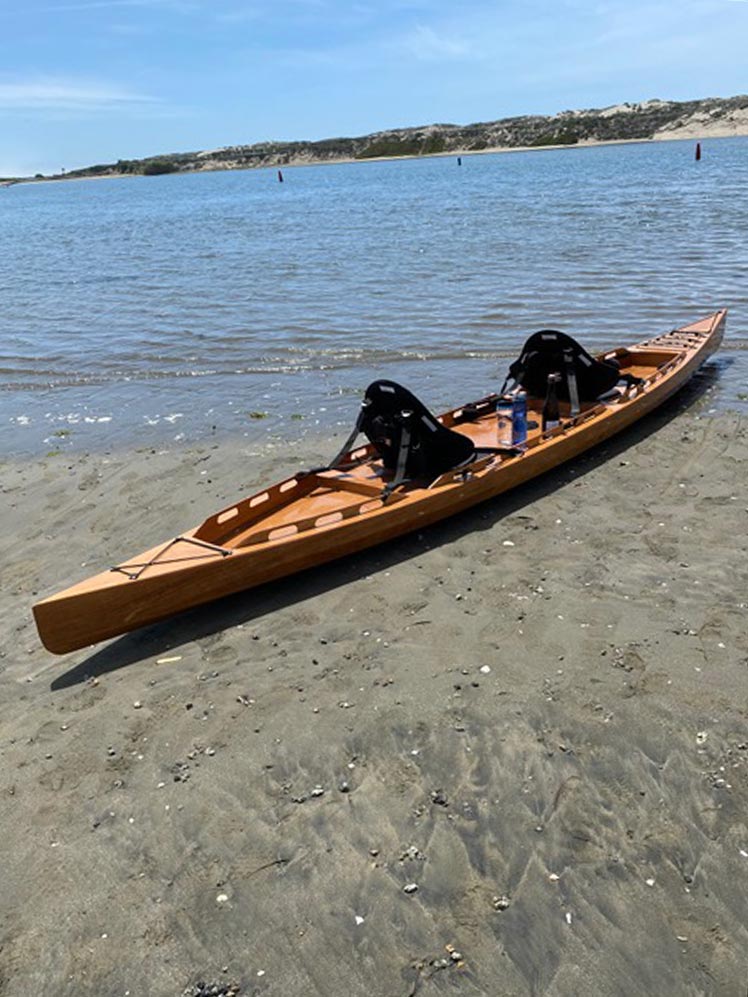
Enhanced Stability
The design of tandem kayaks inherently provides enhanced stability, a feature that is particularly beneficial for families and beginners. The increased width of these kayaks creates a larger contact area with the water, which, according to simple physics, results in a more stable vessel compared to solo kayaks.
This stability is not just theoretical; it’s practical, allowing paddlers to feel more secure, even to the point where standing up in a tandem kayak is less likely to cause it to tip over.
This makes tandem kayaks an excellent choice for those who may be apprehensive about kayaking or for parents wanting to keep a watchful eye on their children during a family outing on the water.
Moreover, the stability of a tandem kayak is not compromised by its size. Despite being wider, tandem kayaks are also longer, which enhances their aerodynamics and ability to cut through water with less resistance.
This combination of width and length means that tandem kayaks can offer a stable yet efficient ride, allowing paddlers to enjoy the serenity of the water without the worry of instability that can come with narrower, solo kayaks.
The result is a paddling experience that is both reassuring and enjoyable, making tandem kayaks a preferred option for a variety of kayakers, from novices to those looking for a stable platform for photography, fishing, or simply soaking in the surroundings.
Increased Speed

Contrary to what one might assume, the wider build of a tandem kayak does not necessarily equate to slower speeds. In fact, the length of tandem kayaks often contributes to a more aerodynamic shape, allowing them to glide through the water with greater efficiency.
The hull design is optimized to cut through the water with minimal resistance, which can result in increased speed when two paddlers work in harmony.
With both individuals contributing to the propulsion, tandem kayaks have the potential to outpace single kayaks, especially over longer distances where the combined strength and rhythm of two paddlers can maintain a consistent and swift forward motion.
It’s important to note, however, that achieving this increased speed in a tandem kayak requires effective communication and coordination between the paddlers.
When both participants synchronize their strokes and work as a cohesive unit, they can harness the full potential of the kayak’s design for a faster and more exhilarating journey.
This collaborative effort not only makes for a quicker trip but also enhances the overall kayaking experience, as partners share in the achievement of propelling their vessel swiftly across the water’s surface.
Shared Experience
Embarking on a journey in a tandem kayak transcends the mere act of paddling; it fosters a shared experience that can strengthen bonds and create lasting memories.
Whether it’s family members navigating through tranquil waters or new friends tackling the challenges of a flowing river, tandem kayaking offers a unique opportunity for collaboration and companionship.
The shared effort required to maneuver the kayak not only builds trust and teamwork but also allows for shared moments of discovery and enjoyment of the natural world.
This collective adventure can be particularly rewarding, as it combines the physical benefits of kayaking with the emotional satisfaction of shared achievement and connection.
Moreover, tandem kayaking serves as a social platform, opening doors to meet like-minded individuals and forge new friendships. Paddling in unison with someone else requires clear communication, which can enhance interpersonal skills and deepen understanding between partners.
The camaraderie developed on the water often extends beyond the confines of the kayak, leading to enduring friendships and future paddling excursions.
Whether it’s through the laughter shared over a tricky maneuver or the silent appreciation of a stunning sunset, the essence of tandem kayaking lies in the joy of sharing the experience with others.
Considerations Before Using a Tandem Kayak

Communication and Coordination
When considering the use of a tandem kayak, the importance of communication and coordination between paddlers cannot be overstated. The success of a tandem kayaking trip hinges on the ability of the partners to effectively communicate their movements and intentions.
This is crucial for synchronizing paddle strokes, which is essential for maintaining a steady pace and direction. The stronger paddler typically takes the rear seat to allow the front paddler to set the rhythm, thereby preventing paddle clashes and ensuring a smooth ride.
Clear, ongoing communication is key to adapting to each other’s styles and making quick decisions, especially when navigating through challenging waters or adjusting to changing conditions.
Coordination extends beyond mere stroke synchronization; it encompasses the overall management of the kayak, including entering and exiting the vessel, weight distribution, and maneuvering strategies.
Partners must work together to balance the kayak, which involves coordinating shifts in body weight and paddling techniques to navigate turns and maintain stability.
Regular practice and a willingness to learn from each other can significantly improve coordination over time, transforming potential difficulties into a seamless paddling experience.
Remember, tandem kayaking is not just about the physical act of paddling—it’s about building a partnership on the water that thrives on mutual trust and cooperation.
Weight Distribution
Proper weight distribution is a critical consideration when setting out in a tandem kayak. It’s essential to balance the load between the two paddlers and any additional gear to ensure optimal performance and safety.
The kayak’s weight capacity should be respected, with a recommended 10 – 20 lbs of leeway to accommodate potential changes in gear or partners, as advised by GILI Sports.
When calculating the total weight, include both paddlers and all equipment to ensure it falls below the kayak’s limit.
This not only affects the kayak’s stability and maneuverability but also impacts the ease of paddling and the overall enjoyment of the journey.
Additionally, the paddler’s positions play a significant role in weight distribution. The more experienced or stronger paddler should ideally take the rear seat to steer and control the kayak’s direction, while the front paddler focuses on setting the pace.
This arrangement also allows for better weight management, especially if paddling solo at times, by adjusting the seat configuration to maintain the kayak’s balance. It’s worth noting that the kayak’s design, including its length and width, will influence its weight and how it handles on the water.
Therefore, selecting a kayak with the right dimensions and weight capacity is crucial for a comfortable and safe tandem kayaking experience.
Storage and Transportation
When it comes to tandem kayaks, storage and transportation are key factors to consider before hitting the water. Tandem kayaks offer ample storage space, with sealed hatches at the bow and stern to keep gear dry, and additional compartments for easy access to essentials.
This makes them ideal for longer trips where camping gear and larger items are needed. However, the convenience of extra storage comes with the responsibility of even weight distribution.
Paddlers must ensure that the load is balanced to maintain the kayak’s stability, taking into account the combined weight of both paddlers and their gear to avoid overloading and potential capsizing.
Transporting a tandem kayak also requires some planning. Due to their increased length, typically around 13 feet, hardshell tandem kayaks can be more challenging to transport than their solo counterparts.
If you’re considering a hardshell model, you may need to invest in a specialized kayak trailer, as noted by GILI Sports. For those with limited storage space, an inflatable tandem kayak could be a more practical solution, offering the advantage of being packed away compactly when not in use.
Regardless of the type, it’s essential to consider both the storage at home and the means of transportation to ensure that your tandem kayak adventures are both enjoyable and feasible.
Tips for Using a Tandem Kayak
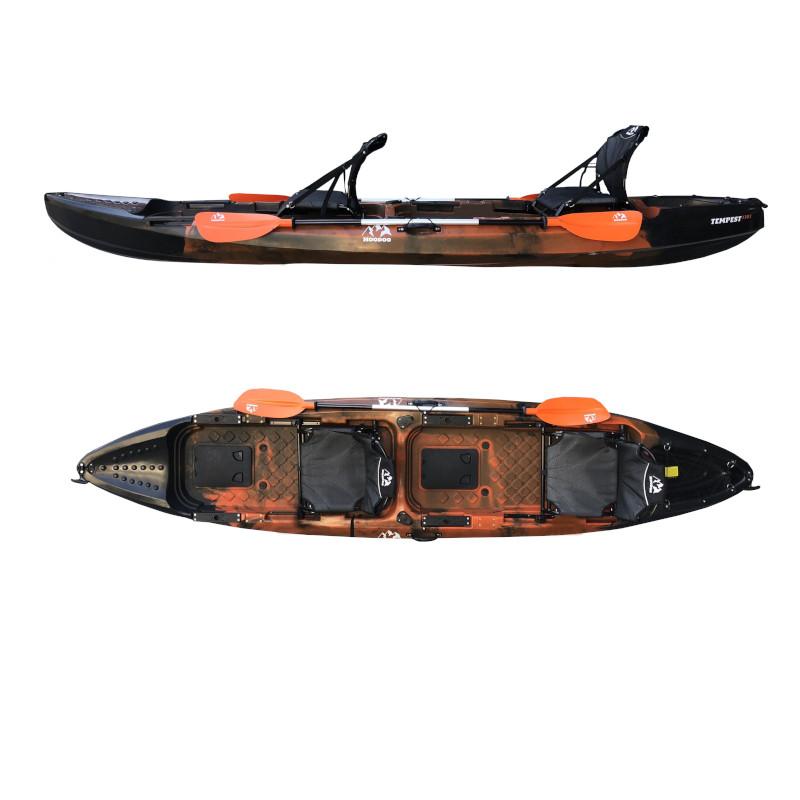
Communication is Key
Mastering the art of tandem kayaking hinges on effective communication between paddlers. It’s the cornerstone of a harmonious journey, ensuring that paddle strokes are synchronized to maximize efficiency and minimize the risk of clashing paddles.
The front paddler sets the rhythm, while the rear paddler, often the stronger of the two, follows suit and provides directional guidance. This dynamic requires clear and continuous dialogue, as well as a willingness to adapt to each other’s paddling styles.
As emphasized by Bay Sports, the stronger paddler sitting at the back can also take the lead in adjusting their strokes to maintain pace, highlighting the importance of cooperation and mutual understanding.
Moreover, regular communication allows for timely breaks and technique reassessments, which are crucial during extended paddling sessions. It’s not just about avoiding physical fatigue but also about maintaining a positive shared experience.
Whether it’s a casual outing or a more challenging expedition, the ability to openly discuss preferences and concerns can significantly enhance the tandem kayaking adventure. Remember, the journey is as much about the relationship between the paddlers as it is about the physical act of kayaking itself.
Practice Makes Perfect
As with any skill, proficiency in tandem kayaking comes with practice. The unique challenge of coordinating paddle strokes with a partner means that time spent on the water is invaluable. Paddlers must learn to match their rhythm and power to move the kayak efficiently and in unison.
This not only propels the kayak forward more swiftly but also prevents the frustrating and potentially dangerous issue of paddle clashing. The process of achieving such synchronization is a gradual one, often requiring multiple outings to perfect.
As highlighted by Evolution Expeditions, beginners can benefit greatly from this practice, as it allows them to build confidence and skill in a supportive environment.
Additionally, the placement of the stronger paddler at the rear of the kayak is a strategic move that can facilitate better stroke alignment and pace control. This setup enables the more experienced paddler to subtly correct the course and match the front paddler’s tempo, creating a smoother ride.
It’s a technique that’s especially beneficial for mixed-ability pairs, such as an adult and child or a novice and a veteran kayaker.
Over time, with patience and persistence, tandem kayakers can develop a seamless partnership that makes navigating the waters a truly enjoyable and rewarding experience.
Enjoy the Experience
Amidst the focus on technique and coordination, it’s essential to remember the fundamental reason for tandem kayaking: to enjoy the shared adventure.
The unique experience of gliding through the water with a companion amplifies the joys of kayaking, from the serene moments of quiet paddling to the exhilarating bursts of speed. It’s an opportunity to create lasting memories, whether you’re navigating through tranquil lakes or exploring rugged coastlines.
Embracing the journey together, with all its challenges and triumphs, fosters a deeper connection with your paddling partner and with the natural world around you.
Moreover, the sense of accomplishment that comes from mastering tandem kayaking is unparalleled. As you and your partner become more attuned to each other’s movements and develop a rhythm that feels almost second nature, the kayak becomes an extension of your collective effort.
This harmony allows you to take in the sights, sounds, and sensations of the environment more fully, making each outing a unique and enriching experience.
So, while the technical aspects are important, don’t lose sight of the simple pleasure that comes from sharing the water with someone else. After all, the essence of tandem kayaking is found in the laughter, the conversations, and the quiet companionship that unfolds with each paddle stroke.
Conclusion
In sum, a tandem kayak offers a distinctive blend of stability, speed, and shared experience that can enhance your adventures on the water. Whether you’re a seasoned kayaker or a beginner, the benefits of paddling in tandem are numerous, from the practicality of storage and transportation to the joy of companionship.
By prioritizing communication, coordination, and practice, you can transform potential challenges into a harmonious and efficient partnership.
The journey of tandem kayaking is not just about reaching your destination but also about the growth, connection, and memories you create along the way.
Ultimately, the essence of what is a tandem kayak transcends the physical vessel—it’s about the bond formed between paddlers as they navigate the waters together. It’s a shared endeavor that can lead to improved skills, increased confidence, and a deeper appreciation for the sport.
So, embrace the opportunity to explore the world of tandem kayaking, where each stroke brings you closer to nature and to one another.
With every adventure, you’ll discover that the true value of a tandem kayak lies in the experiences it enables and the stories it helps to tell.
Sources:
- https://www.boteboard.com/blogs/experience/a-beginners-guide-to-tandem-kayaking
- https://www.baysports.com.au/blogs/blog/what-is-a-tandem-kayak
- https://www.gilisports.com/blogs/kayaking/ultimate-guide-to-buying-a-tandem-kayak
- https://www.evolutionexpeditions.com/blog/what-is-tandem-kayaking
- https://kayakketchikan.com/blog/double-kayaks/
FAQ
-
Is tandem kayaking harder than single?
Here are some points to consider: Maneuverability: Single kayaks are generally easier to maneuver compared to double kayaks. With a single kayak, you have complete control over the direction and movements of the kayak since you are the sole paddler.
-
Why are tandem kayaks called divorce boats?
We jokingly call these “divorce boats” because some couples fight over which way they are going. Unlike a tandem bike where the pedals move at the same time regardless of what each partner is doing, the paddling pair must really work well together to make it down the river.
-
Can you solo a tandem kayak?
Yes, Just make sure to get a cap for the unused hatch so that it doesn’t fill with water if you’re in rough conditions. Also I would recommend sitting in the back where the rudder controls are (in most tandem kayaks). A tandem is a bit trickier to handle without a rudder than a single.
-
Who should sit in the back of a tandem kayak?
TIPS FOR PADDLING A TANDEM KAYAK Second, the stronger of the two paddlers should sit in the rearmost position. The rear paddler should be the one to match the stroke of the front paddler, since they can watch the stroke of the front paddler.

